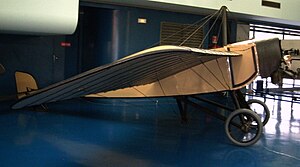The Morane-Saulnier H was an early aircraft first flown in France in the months immediately preceding the First World War; it was a single-seat derivative of the successful Morane-Saulnier G with a slightly reduced wingspan[1][2] Like the Type G, it was a successful sporting and racing aircraft: examples serving with the French army were used in the opening phases of the war.
| Type H | |
|---|---|

| |
| Morane Saulnier Type H on display at the Musée de l'Air et de l'Espace at Paris Le Bourget airport | |
| Role | Sport aircraft |
| Manufacturer | Morane-Saulnier |
| First flight | 1913 |
| Developed from | Morane-Saulnier G |
| Variants | Morane-Saulnier L |
German versions, the Fokker Eindecker fighters, were armed with forward-firing machine guns and became the first single-seat fighter aircraft so armed.
Service use
editDuring the second international aero meet, held at Wiener Neustadt in June 1913, Roland Garros won the precision landing prize in a Type H.[3] Later that same year, a Morane-Saulnier H was used to complete the first non-stop flight across the Mediterranean, from Fréjus in the south of France to Bizerte in Tunisia.[4]
The French Army ordered a batch of 26 aircraft under the designation MoS.1.[2] French-built machines saw limited service in the opening stages of World War I, with pilots carrying out reconnaissance missions and occasionally engaging in aerial combat using revolvers and carbines.[2] The British Royal Flying Corps also acquired a small number, impressing three civilian-owned aircraft on the outbreak of the war, and ordering 36 machines Grahame-White, who was manufacturing the type in the UK under licence in two batches. The RFC mainly used the Type Hs for training, with only one example seeing service with operational squadrons (4 and 12 Squadrons).[5]
German copies
editA German-built copy entered production as the Fokker M.5 in 1913: it featured a slightly longer fuselage, framed in steel tube rather than wood, a comma shaped rudder, and a redesigned undercarriage integrated with the under-wing bracing pylons. When armed in 1915 with a synchronised machine gun it became the first of the Fokker "Eindecker" monoplane fighters.[6]
The type was also produced under licence in Germany by the Pfalz Flugzeugwerke: during the war the company built armed versions as the E.I, E.II, E.IV, E.V, and E.VI, with increasingly powerful engines. Like the better known Fokkers, with which they were often confused by Allied airmen, these were armed with a single, synchronised lMG 08 machine gun.[7][8]
Survivors
editA Type H is preserved at the Musée de l'Air et de l'Espace in Le Bourget and another at the Fantasy of Flight in Florida. Several replicas are in museums or flying.
Variants
editMorane-Saulnier versions
edit- Type G two seater
- Type H single seater
- Type L parasol monoplane
- Type M armoured single seater
- Type O racing monoplane developed from H, two built including one for Roland Garros that was fitted with wheels and floats
- MoS.1 Official designation for Type H
- MoS.2 Official designation for Type G
- MoS.3 Official designation for Type L
- MoS.13 Official designation for Type M
Pfalz versions
edit- E.I - with Oberursel U.0 rotary engine (45 built)[9]
- E.II - with Oberursel U.I rotary engine (130 built)[10]
- E.IV - with Oberursel U.III rotary engine (46 built)[11]
- E.V - with Mercedes D.I water-cooled, inline engine (20 built)[12]
- E.VI - with Oberursel U.I engine, lengthened fuselage, enlarged tail fin and reduced bracing (20 built as trainers)[13][14]
Operators
edit- Austro-Hungarian Navy - (Pfalz-built versions)
- Army Flying Service - 2 examples.
- Luftstreitkräfte - (Pfalz-built versions)
- Portuguese Air Force - one aircraft.
- Swiss Air Force - two aircraft
Specifications
editGeneral characteristics
- Crew: One pilot
- Length: 5.84 m (19 ft 2 in)
- Wingspan: 9.12 m (29 ft 11 in)
- Height: 2.26 m (7 ft 5 in)
- Empty weight: 188 kg (415 lb)
- Gross weight: 444 kg (979 lb)
- Powerplant: 1 × Le Rhône 9C , 60 kW (80 hp)
Performance
- Maximum speed: 120 km/h (75 mph, 65 kn)
- Range: 177 km (111 mi, 96 nmi)
- Service ceiling: 1,000 m (3,280 ft)
References
edit- ^ Taylor 1989, p.648
- ^ a b c "The Illustrated Encyclopedia of Aircraft", p.2539
- ^ Hartmann 2001, p. 11
- ^ Flying the Mediterranean Flight 27 September 1913
- ^ Bruce 1982, pp. 287–289
- ^ Brannon (1996), pp.7-9
- ^ The Illustrated Encyclopedia of Aircraft, p.2698
- ^ Grosz 1996
- ^ Herris 2001, p.10
- ^ Herris 2001, p.16
- ^ Herris 2001, p.21
- ^ Herris 2001, p.24
- ^ Herris 2001, p.25
- ^ Grosz 1996, p.27
Bibliography
edit- Brannon, D. Edgar (1996). Fokker Eindecker in Action. Carrollton, Texas: Squadron/Signal Publication.
- Bruce, J. M. (1982). The Aeroplanes of the Royal Flying Corps (Military Wing). London: Putnam. ISBN 0-370-30084-X.
- Davilla, Dr. James J.; Soltan, Arthur (1997). French Aircraft of the First World War. Mountain View, CA: Flying Machines Press. ISBN 978-1891268090.
- Grosz, P.M. (1996). Pfalz E.I–E.VI. Berkhamsted, Hertfordshire: Albatros Publications.
- Hartmann, Gérard (2001). "L'incroyable Morane-Saulnier hydro" (PDF). La Coupe Schneider et hydravions anciens/Dossiers historiques hydravions et moteurs. Retrieved 2008-11-07.
- Herris, Jack (2001). Pflaz Aircraft of World War I. Boulder, Colorado: Flying Machines Press. ISBN 1-891268-15-5.
- The Illustrated Encyclopedia of Aircraft. London: Aerospace Publishing.
- Neulen, Hans-Werner & Cony, Christophe (August 2000). "Les aigles du Kaiser en Terre Sainte" [The Kaiser's Eagles in the Holy Land]. Avions: Toute l'Aéronautique et son histoire (in French) (89): 34–43. ISSN 1243-8650.
- Taylor, Michael J. H. (1989). Jane's Encyclopedia of Aviation. London: Studio Editions.
- Angelucci, Enzo (1983). The Rand McNally encyclopedia of military aircraft, 1914-1980. The Military Press. p. 20. ISBN 0-517-41021 4.
Further reading
edit- Lacaze, Henri & Lherbert, Claude (2013). Morane Saulnier: ses avions, ses projets [Morane Saulnier: Their Aircraft and Projects] (in French). Outreau, France: Lela Presse. ISBN 978-2-914017-70-1.